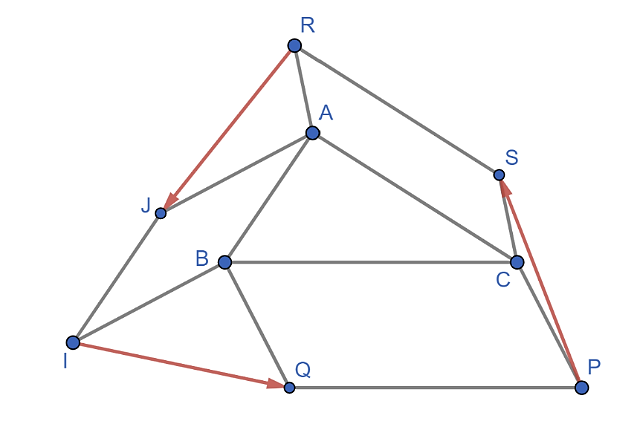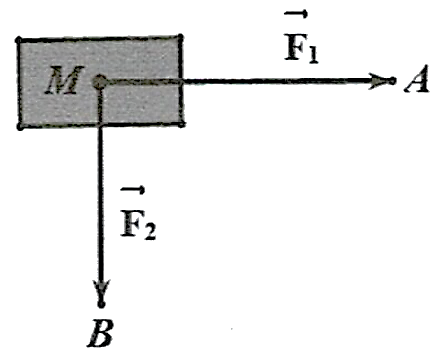Cho bốn điểm phân biệt \[A,B,C,D\]. Vectơ tổng \[\overrightarrow {AB} + \overrightarrow {CD} + \overrightarrow {BC} + \overrightarrow {DA} \] bằng
Quảng cáo
Trả lời:
Đáp án đúng là: A
Ta có \[\overrightarrow {AB} + \overrightarrow {CD} + \overrightarrow {BC} + \overrightarrow {DA} = \left( {\overrightarrow {AB} + \overrightarrow {BC} } \right) + \left( {\overrightarrow {CD} + \overrightarrow {DA} } \right) = \overrightarrow {AC} + \overrightarrow {CA} = \overrightarrow {AA} = \overrightarrow 0 \].
Hot: 1000+ Đề thi cuối kì 1 file word cấu trúc mới 2025 Toán, Văn, Anh... lớp 1-12 (chỉ từ 60k). Tải ngay
- Trọng tâm Lí, Hóa, Sinh 10 cho cả 3 bộ KNTT, CTST và CD VietJack - Sách 2025 ( 40.000₫ )
- Trọng tâm Toán, Văn, Anh 10 cho cả 3 bộ KNTT, CTST, CD VietJack - Sách 2025 ( 13.600₫ )
- Sách lớp 10 - Combo Trọng tâm Toán, Văn, Anh và Lí, Hóa, Sinh cho cả 3 bộ KNTT, CD, CTST VietJack ( 75.000₫ )
- Sách lớp 11 - Trọng tâm Toán, Lý, Hóa, Sử, Địa lớp 11 3 bộ sách KNTT, CTST, CD VietJack ( 52.000₫ )
CÂU HỎI HOT CÙNG CHỦ ĐỀ
Lời giải

a) Đúng. Theo quy tắc ba điểm, ta có \(\overrightarrow {RJ} = \overrightarrow {RA} + \overrightarrow {AJ} \).
b) Sai. Ta có \(\overrightarrow {IQ} = \overrightarrow {IB} + \overrightarrow {BQ} \).
c) Sai. Ta có \(\overrightarrow {PS} = \overrightarrow {PC} + \overrightarrow {CS} \).
d) Đúng. Do \(CARS\) là hình bình hành nên \(\overrightarrow {RA} = \overrightarrow {SC} \).
Do \(ABIJ\) là hình bình hành nên \(\overrightarrow {AJ} = - \overrightarrow {IB} \).
Khi đó, \(\overrightarrow {RJ} = \overrightarrow {RA} + \overrightarrow {AJ} = \overrightarrow {SC} - \overrightarrow {IB} \).
Do \(BCPQ\) là hình bình hành nên \(\overrightarrow {BQ} = \overrightarrow {CP} \).
Khi đó, \(\overrightarrow {IQ} = \overrightarrow {IB} + \overrightarrow {BQ} = \overrightarrow {IB} + \overrightarrow {CP} \).
Vậy ta có \(\overrightarrow {RJ} + \overrightarrow {IQ} + \overrightarrow {PS} \)\[ = \left( {\overrightarrow {SC} - \overrightarrow {IB} } \right) + \left( {\overrightarrow {IB} + \overrightarrow {CP} } \right) + \left( {\overrightarrow {PC} + \overrightarrow {CS} } \right)\]\(\)
\( = \left( {\overrightarrow {SC} + \overrightarrow {CS} } \right) + \left( {\overrightarrow {IB} - \overrightarrow {IB} } \right) + \left( {\overrightarrow {CP} + \overrightarrow {PC} } \right) = \overrightarrow 0 \).
Vậy \(\overrightarrow {RJ} + \overrightarrow {IQ} + \overrightarrow {PS} = \vec 0\).
Lời giải

Giả sử \(\overrightarrow {{F_1}} = \overrightarrow {OA} \), \(\overrightarrow {{F_2}} = \overrightarrow {OB} \).
Theo quy tắc hình bình hành, suy ra \(\overrightarrow {{F_1}} + \overrightarrow {{F_2}} = \overrightarrow {OC} \), như hình vẽ.
Ta có \(\widehat {AOB} = 60^\circ \), \(OA = OB = 50\), nên tam giác \(OAB\) đều, suy ra \(OC = 50\sqrt 3 \).
Vậy \(\left| {\overrightarrow {{F_1}} + \overrightarrow {{F_2}} } \right| = \left| {\overrightarrow {OC} } \right| = 50\sqrt 3 \,\,({\rm{N}}) \approx 86,6\,\,{\rm{(N)}}\).
Đáp án: 86,6.
Câu 3
Lời giải
Bạn cần đăng ký gói VIP ( giá chỉ từ 199K ) để làm bài, xem đáp án và lời giải chi tiết không giới hạn.
Câu 4
Lời giải
Bạn cần đăng ký gói VIP ( giá chỉ từ 199K ) để làm bài, xem đáp án và lời giải chi tiết không giới hạn.
Lời giải
Bạn cần đăng ký gói VIP ( giá chỉ từ 199K ) để làm bài, xem đáp án và lời giải chi tiết không giới hạn.
Câu 6
Lời giải
Bạn cần đăng ký gói VIP ( giá chỉ từ 199K ) để làm bài, xem đáp án và lời giải chi tiết không giới hạn.
